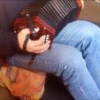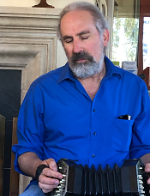-
Posts
99 -
Joined
-
Last visited
Profile Information
-
Gender
Male
-
Location
Berlin
Recent Profile Visitors
1,735 profile views
Sebastian's Achievements

Advanced Member (3/6)
-
Some years ago I purchased a double reeded 20 button German 'tina from Oliver Stoffregen (diatonie.de). It was a Silvetta model with some important improvements (limited button travel, equal temperament). After years of use it has become a bit unreliable, and I wonder if it is possible to get a similar instrument. Silvetta has ceased production. Stagi makes the C-2 & C-3 models, but I don't like their key lever mechanism, especially their wobbly buttons. Does anyone know where I could receive a double reeded 20 button concertina with limited button travel and equal temperament in new or as-new condition?
-
Yes. PC reached concertina.net, and I personally, I don’t like NPCs. Toodeloo! ??
-
Who is the 'us' in your question? It’s not important to me, but it seems important to you. (Now searching the 'unregister'-option.)
-

What is "German-made double reeded concertina" ?
Sebastian replied to Devils' Dream's topic in Concertina Videos & Music
I am under the impression, that these were essencially two-row concertinas with only one reed per note (the instrument on the photograph most likely is). Those were easily replaceable by the more pricey anglo-german three-row conertinas, when people got a bit wealthier, because with these you could still play in the old way but had some new possibilities and still the thin sound of single-reeded instruments. For the irish playing style (= fiddle imitation, devoid of chord playing) the anglo-german concertinas with one reed per note may indeed have been a somewhat useful expansion. With regard to zulu music I lack enough knowledge and don’t know, whether the two-row concertina with two reeds per note could have made any impact. But until some information to the contrary comes up, I would be sceptical. South african boer music is really the only music I know of where the "german double reeded concertina" with its typical rich sound could attain at least some sort of to some extend established position. -

What is "German-made double reeded concertina" ?
Sebastian replied to Devils' Dream's topic in Concertina Videos & Music
I think the only muscial culture they were able to put little mark on is the southafrican boremusik. https://youtu.be/zeMfpcAkXA0 -

What is "German-made double reeded concertina" ?
Sebastian replied to Devils' Dream's topic in Concertina Videos & Music
It is an anglo-german concertina without the "anglo"-part, that is, without the accidental-row, but with two reeds per note, tuned an octave apart. Inicidentally, it’s the concertina I am playing. You may take a look at it in my YT-clips, if you want to see it 'in action'. -

One of the stranger concertina pics I've seen
Sebastian replied to Daniel Hersh's topic in Concertina History
Do you mean the flowery ornation? Yes, it’s a bit exuberant. :) I would like to know on what occasion this picture has been taken. :) -

One of the stranger concertina pics I've seen
Sebastian replied to Daniel Hersh's topic in Concertina History
Hm. What is stranger on this postcard than on others? ? -
Yes, from the harmonica. It is common for any wind instrument (in the cultural context of western music) that you blow into them instead of sucking through them. So the first free reed instruments where all-blow instruments, and even later the blow reeds constitute the basic, the tonic chord. (There is for example the traditional one row accordion in the region of Saratov, which has the inverted push-pull pattern.)
-
»how do i make a song playable on concertina?« 40 buttons are far to many to get a good understanding of the concertina. You should consider a 20 button concertina.
-
They may be younger than you and thus still a bit untamed …
-
Yes, this are the dots from the YT video as ABC notation. I did this for @mathhag (and for myself ;) ), it doesn't take much time. What can you do with it? You can copy and past it on http://www.mandolintab.net/abcconverter.php to render it again as normal musical notation. You can let the computer transpose it for you from the key of A minor to E minor or another key which is maybe better suited for your concertina. You can make the computer play it for you at a speed you like and in a key you like. I don't play anglo, so I can't help you with playing advice (but I'm sure someone else can). I can only say how I would play it on a 20 button concertina.
-
X:1 T:Kashiwas Thema M:3/4 L:1/8 K:Am E>F E/^D/E/c/ | "E7" B6 | z2 E>F E/^D/E/B/ | "Am" A6 | "A7" z2 A>_B A/^G/A/[eg]/ | "Dm" [df]2 z[df] [df]2 | "G" [df]z [eg]z [df]z | "C" [df]z [ce]4 | z2 zc de | "E7" e3 d d2- | d2 zd ed | "Am" d3 c c2- | c2 z2 AB | "F7" c3 d c2 | "E7" Bz ez cz | "Am" A6 | z4 A/B/^c/d/ || "A" e3 A A2- | A2 ^c2 e2 | "Dm" g2 f3 e | f6 | "G" d3 G G2- | G2 B2 d2 | "C" f2 e3 ^d | e6 | "F" A3 B c2 | "C" G4 e2 | "E7" f3 e B2 | "Am" c6 | "F" A4 a2 | "F7" a3 ^g a2 | "E7" b4 ^g2 | e6 | "A" e3 A A2- | A2 AB ^cd | "A7" e6 | e3 e fg | "F" [ca]6 | "G7" [Ba]4 g/a/g/f/ | "C7" [_Bg]4 (3fgf | "A7" [^ce]6 | "Dm" [Ad]3 e f2 | "E7" [^Gf]2 e2 d2 | "Am" [Ac]4 [Bd]2 | [ce]2 a2 c'2 | "Dm" [db]4 a2 | "E7" [B^g]3 ^f g2 | "Am" [cea]6 | "D" [d^fa]6 | "Am" [cea]6 | H[cea]2 |]
-

Information about my first concertina
Sebastian replied to codygoodman1337's topic in Concertina History
Bastari is today Brünner in Italy. They sell mostly under the brand name 'Stagi'. You can look at their actual range of concertinas here. Your model is a classical 20 button 'german' concertina, much like they are produced since the 1840's. I play a 20 button 'german' concertina too, and here is one example of what you can do with it: https://soundcloud.com/weltsauerstoff/im-a-pirate -

New to Concertina and music in general
Sebastian replied to codygoodman1337's topic in Teaching and Learning
Druck is "push" and Zug is "pull". You need only the numbers from 1 to 5. Above the horizontal line is the right hand and below is the left hand. The digits on the right of each D or Z show the buttons to press: The superscript digits denote the outer row (C row), the subscript digits denote the inner row (G row). The button numbering goes from left to right (1 = deep sound, 5 = high sound).


.thumb.jpeg.09943e9e2f2a23918324c6151aa2597b.jpeg)






